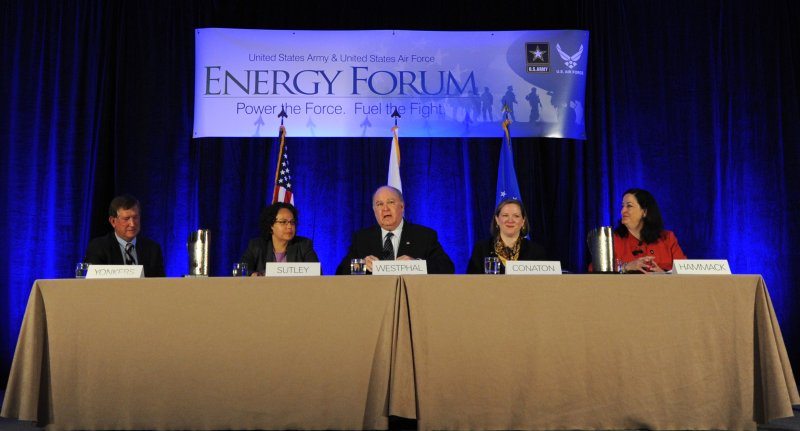Senior leaders from the Department of Defense, federal agencies, Air Force and Army discussed the strategic importance and way ahead for energy solutions during the Army-Air Force Energy Forum here July 19.
The two-day event enables hundreds of attendees to get a clearer perspective from military officials, industry experts and Congress about the needs and best practices of both service branches to reduce dependence on foreign sources of oil and increase domestic capabilities and supplies.
“We care about energy because we want the warfighters to have what they need to fight downrange,” said Undersecretary of the Air Force Erin Conaton. “The dependence we’ve seen on fossil fuels creates vulnerability not only from a supply aspect but a cost aspect, so that drives us to both decrease our demand for these resources and to diversify the sources of supply.”
Conaton elaborated on the criticality of energy awareness in modern-day practical terms.
“Every dollar we’re not spending on fuel is a dollar that can either be put toward reducing the country’s deficit or reinvested toward the warfighting capabilities that make our Soldiers, Airmen, Marines and Sailors more effective wherever they’re being deployed,” Conaton said.
During the panel discussion, Assistant Secretary of the Air Force for Installations, Energy and Environment Terry Yonkers championed partnerships with industry and other agencies.
“More than ever we are reaching out to communities, civic leaders, academia and the private businesses that support us every day and there is a tremendous national will and focus in the Congress on energy security,” Yonkers said, adding that commanders are implementing cross-service initiatives for deployed and stateside forces to improve how installations treat their energy resources.
“In the Air Force, we are aggressively pursuing efficiencies in our infrastructure by making smart investments in upgrading (heating, ventilation and air conditioning) systems, lighting, insulation and bringing all new buildings (up to) LEEDs (Leadership in Energy and Environmental Design) silver compliant,” Yonkers said. “We’re seeking to add an additional 1,000 megawatts of renewable energy capacity on our bases over the next few years and we’re aggressively pursuing the replacement of conventional vehicles with all electric vehicles.”
Air Force officials also have integrated technology to better leverage energy efficiency on bases.
“We’re ensuring greater installation security through ideas such as microgrids, smart meters and renewable energy sources linked together in a ‘system-of-systems’ approach,” Yonkers said.
On the operational side, Yonkers said plans are in place to reduce fuel demands by hundreds of thousands if not millions of gallons per year. The reductions, he explained, would be the result of developing domestic alternative fuel sources from such things as algae, camelina, animal fats and biomass.
As efforts continue to certify aircraft and ground vehicles to use these alternative fuels once they become available, Assistant Secretary of the Army for Installations, Energy and Environment Katherine Hammack said she and Yonkers have been traveling to joint bases in which Soldiers and Airmen work together so they can better gauge energy issues.
“In this era of fiscal constraint, where we’re all trying to do more with less, by the services working closely together, we’re able to leverage the amount of resources that we have,” Hammack said, adding that the Army-led ‘Net-Zero’ program, for example, is designed to increase basing power by limiting installation energy and water use to no more than it can produce.
Forum panelists acknowledged that though the administration has put a renewed focus on energy initiatives, the energy challenge has been perennial and the influence on military and civilian communities great.
“Every president since Richard Nixon has talked about reducing our dependence on imported oil as a primary source of powering our country and nobody knows better the impact of that dependence than the Department of Defense and the armed services,” said Nancy Sutley, Council on Environmental Quality. “The federal government is the single largest energy consumer in the U.S. economy, and the Department of Defense and the armed services are the single largest consumers of energy within the federal government.”
Energy forum plenary panel and breakout sessions covered topics ranging from installation energy management, alternative liquid fuels, cyber security and movement of energy into and throughout the U.S. Central Command theater of operations.
“While we have come a long way in a few short years, there remains much more to be done,” Yonkers said. “As we become more energy efficient and secure, we’re also becoming more environmentally responsible.”










